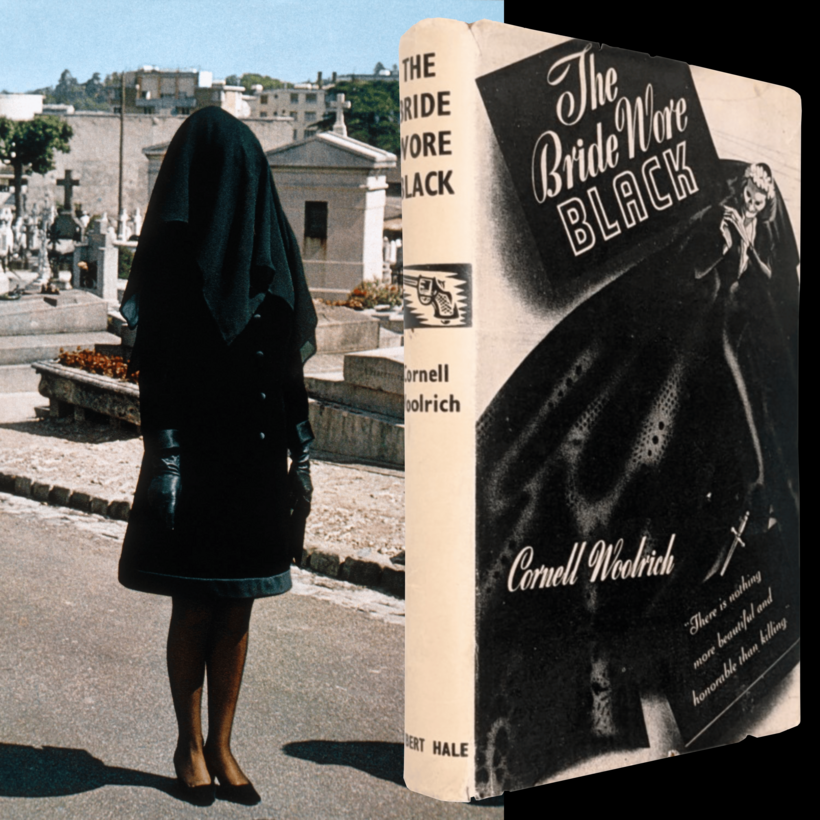No one much liked the solitary writer Cornell Woolrich, except Hollywood, which devoured many of his noir novels and short stories, with their ingenious plots, solitary losers, and complicated protagonists.
Alfred Hitchcock turned one of Woolrich’s novelettes into Rear Window, for which Woolrich was paid the grand sum of $650. (“But that’s not what bothered me,” Woolrich later recalled. “What bothered me was that Hitchcock wouldn’t even send me a ticket to the premiere in New York. He knew where I lived.”)
François Truffaut cast Jeanne Moreau as a young widow out to avenge the death of her husband in his adaptation of Woolrich’s The Bride Wore Black. Jacques Tourneur’s The Leopard Man, Robert Siodmak’s Phantom Lady, John Farrow’s Night Has a Thousand Eyes, Tobe Hooper’s I’m Dangerous Tonight: all were based on Woolrich’s work.
As late as the 1980s and 1990s, film adaptations continued to crop up, such as Union City, with Debbie Harry, in 1980, and Richard Benjamin’s Mrs. Winterbourne, in 1996, based on Woolrich’s I Married a Dead Man (a remake of No Man of Her Own, which was adapted in 1950). In 1998, a wheelchair-bound Christopher Reeve starred in a remake of Rear Window.

“To me, Cornell Woolrich is the most noir writer of all the writers that came out of that era of hard-boiled pulp fiction,” said Eddie Muller, host of Turner Classic Movies’ Noir Alley. “I’ve always thought of James M. Cain as sort of the architect of noir.... But Woolrich was even darker.... His view of the world was just so dire and so dreadful, and … he was able to get these incredible, thrilling tales of suspense out of such a bleak worldview.”
The only thing more noir than Woolrich’s 27 novels and more than two dozen collections of short stories may have been his own life.
From the Ritz to the Marseilles
In countless noirs, Mexico is often where criminals and born-under-a-dark-cloud losers longed to end up, imagining it a paradise beyond the long arm of the federales. But in the curious case of Cornell Woolrich, Mexico was where his story began.
Though he was born in New York City, Woolrich’s parents took three-year-old Cornell to Mexico, where his father worked as a civil engineer during the Mexican Revolution. Cornell would collect spent cartridges left behind from the fighting. But the marriage didn’t survive the move, and his parents separated. His mother moved back to New York, while Cornell stayed behind with his father, whom he hated.
One bright memory stands out from his early years: as an eight-year-old boy, he saw a touring French production of Madama Butterfly that deeply affected him. As his biographer, Francis M. Nevins, notes, it “gave him a sudden sharp insight into color and drama and his first sense of tragedy, and it also gave him a sense of doom.”

At 17, Woolrich returned to New York to live with his mother, his aunt, and his grandfather in a shabby-genteel house on 113th Street. He attended Columbia University, but he dropped out in his junior year to pursue writing full-time. One of his first stories, the Jazz Age Children of the Ritz, won First National Studios’ $10,000 screenwriting prize. A movie adaptation brought the young author to Hollywood, where he met Violet Blackton, the daughter of J. Stuart Blackton, a co-founder of Vitagraph Studios. They were married in 1930 by a city judge in Santa Ana, and it looked like he had it made. What could possibly go wrong?
Everything.
Soon after returning from their honeymoon, the marriage unconsummated and eventually annulled, Woolrich abandoned both Hollywood and his wife. He had left behind a trunk of clothes and a diary chronicling dozens of encounters with men. Among his effects in that trunk was a sailor suit, most likely bought at a theatrical costume shop, which he wore while cruising the docks.

Woolrich returned to New York, where he moved back in with his mother, at the Hotel Marseilles, on West 103rd Street.
The Jazz Age novel was on its deathbed by the 1930s—the Depression had tightened its grip on the beautiful and the damned—and so Woolrich, unable to find a home for his second novel, tossed it into the wastepaper basket and turned to pulp fiction. The only problem was, he was good at it.
One of the best-known mystery editors of the last century was Simon & Schuster’s Lee Wright, who’d launched the careers of Ira Levin, Donald E. Westlake, and many others. After a chance meeting, Woolrich sent Wright the manuscript of The Bride Wore Black.
“I read it very quickly,” she told Woolrich’s biographer, “and called him at once and said it was magnificent. I never could convince him, though. The curse of working with Woolrich was that once having completed a novel, he viewed it with an absolutely unmixed double reaction. One was that every word he wrote was marvelous, magnificent, shouldn’t be changed. And the other was that everything he wrote was terrible.... There was a while when I thought he was dangerous. We had a penthouse office in the Weber building on 49th Street and Sixth Avenue … and I was afraid that he would throw me through the window someday.”
With The Bride Wore Black, published in 1940, this recluse, unfitted for the world, nonetheless began writing an extraordinary string of “black” suspense novels: The Black Curtain, Rendezvous in Black, The Black Angel, Black Alibi, and The Black Path of Fear, many of them published in French translations. Woolrich’s série noire quickly led the French to acclaim him as the master of a poetically dark vision of the world.

Hollywood, meanwhile, was snapping up crime stories, and, according to Raymond Chandler, Woolrich was the best idea man in the business. Rear Window is based on a Woolrich story that first appeared in the February 1942 issue of Dime Detective Magazine titled “It Had to Be Murder.” Hitchcock and screenwriter John Michael Hayes turned the protagonist, L. B. “Jeff” Jeffries, into a photojournalist, equipping him with a telephoto lens as an excuse for his voyeurism. They also gave Jeff (James Stewart) a glamorous girlfriend—played by Grace Kelly, no less—and a wisecracking nurse (Thelma Ritter). Laid up with a broken leg, Jeff starts spying on the residents of a nearby apartment building, discovering a sordid murder.
Solitary writing suited Woolrich and the increasingly lonely life that he led. Few people even knew him. He occasionally attended the annual dinners hosted by the Mystery Writers of America, where he’d mostly drink by himself in a corner, rudely rebuffing anyone who tried to make conversation. At cocktail parties, he often brought his own bottle of cheap wine in a paper bag and would grumble, “You don’t mean that,” to anyone who dared to say how much they admired his work. He dedicated The Bride Wore Black to his Remington typewriter.
Born to Be Solitary
In Blues of a Lifetime, Woolrich’s only autobiographical work, the writer describes the solitary life he lived while he pounded out story after story: “I live in a hotel in New York. I’ve lived in hotels all my life. I was brought up in them even as a child. I have traveled now and then, but I suspect it was wasted effort. A hotel room is a hotel room. Whether the place outside your windows is called New York, Paris, London or whatnot, they all look alike.”
He found human connection a chore. “I was born to be solitary and I liked it that way,” he wrote. “Deep down inside, I knew … that I wouldn’t have had it otherwise, and that if someone had been waiting somewhere for me with open arms … I would’ve turned and run in the opposite direction as fast as I could.”
He also chronicles in Blues of a Lifetime the sorry decline of the Hotel Marseilles: floors coated with grime, combustible debris in the air shafts, mice scratching in the walls, burglaries, stairs littered with garbage, light bulbs stolen from hallways. He could have afforded better, but habit kept him and his mother tethered to their now decrepit digs. After all, the Marseilles was home.

Earlier, Woolrich had tried to live apart from her. He’d moved to another hotel for three weeks in 1942, until she phoned one night, telling her son, “I can’t live without you. I must live with you. I need you.” Woolrich put down the phone, packed, and returned to the Marseilles, where he remained until his mother’s death, in 1957. Some felt that Woolrich’s relationship to his mother, Claire, may have contributed to Hitchcock’s and screenwriter Robert Bloch’s depiction of Norman Bates and his mother in Psycho.
After her death, a despondent Woolrich stopped writing. He settled into his final hotel, the considerably more elegant Sheraton Russell. His spartan suite of rooms on the second floor—with a bed, a writing table, a lamp, a few chairs, and a TV—looked out over Park Avenue. Next to the closet was a kitchenette and a small bathroom. A visitor recalled, “I never saw a book in his apartment, never saw any kind of reading material. Not a magazine, not a newspaper.”
Every evening, Woolrich came down to the lobby, sat in a favorite chair, and watched the world parade by the window. When the lobby closed, after midnight, Woolrich would return to his room and turn on a late-night movie, looking for the ones based on his stories and novels, which he watched again and again.
Perhaps it was fitting for a man who lived his life in hotels that it was a bellboy who realized that Woolrich needed serious medical help. An infection caused by an ill-fitting shoe festered and became gangrenous. The bellboy called the doctor, but by the time Woolrich was carried out of the hotel and transported to a hospital, it was too late, and his leg was amputated above the knee. “I don’t know if I told you that I lost a gam,” he wrote to an acquaintance.

Woolrich was fitted with an artificial leg, but he hated using it, so his last few months at the Sheraton Russell were spent in a wheelchair, solicitously looked after by the hotel staff, who helped him down to the lobby and into his favorite chair each night. There he would sit, watching the bustling street life outside the hotel door, not unlike Jeff in Rear Window. The only thing he lacked was a telephoto lens.
When Truffaut’s adaptation of The Bride Wore Black (La Mariée État en Noir) premiered, at the Festival Theater on 57th Street and Fifth Avenue in June 1968, he was urged to go. “Don’t you want to see what Truffaut did with your greatest book? François Truffaut will be there and wants to meet you!” But Woolrich demurred. He didn’t want to leave the hotel in a wheelchair.
On September 25, 1968, just short of his 65th birthday, Woolrich died alone in his hotel room. He was taken to the Frank E. Campbell funeral chapel, where he lay for three days, surrounded by flowers sent by Chase Manhattan Bank, the executor of his estate. It turns out he’d left a lot of money, bequeathing Columbia University $850,000 to establish a graduate creative-writing program in his mother’s memory.
Just five people attended the viewing, including the bank representative, the executive secretary for the Manhattan chapter of the Mystery Writers of America, and the managing editor of Ellery Queen’s Mystery Magazine.
When the estate executors went to clear out his hotel room, at the Sheraton Russell, they found it nearly bare. Missing were the manuscripts—thousands of typed pages, the culmination of 45 years of writing. It seems that Woolrich couldn’t bear to have his work around him anymore. The books were gone; he’d given them away to bellboys, maids, casual visitors, the night manager.
By the early 1970s, Woolrich’s books were virtually unavailable. If Alan Nevins (no relation to Francis), the president of Renaissance Literary & Talent, had not tracked down the rights to his work, Woolrich would, perhaps, have remained a mere footnote to the history of noir.
“When I arrived at Renaissance, in 2017, the agency had already been thinking about revamping Woolrich,” Jaclyn Saferstein-Hansen recalls. After reading Francis Nevins’ biography and his fiction, she was hooked. “He was just such a fascinating figure, a tortured artist. And I think that drew me to him more than Raymond Chandler or Dashiell Hammett, who had slightly more conventional lives—married or divorced from women. Woolrich was dealing with his mother and his sexuality.”

“Later in the 20th century, it was almost a requirement that you put yourself out there,” Saferstein-Hansen observes. “But Woolrich produced story after story after story, and basically those stories built a wall around him that protected him from the outside world.”
Beginning in 2018, Saferstein-Hansen began working on getting the rights to Woolrich’s prodigious body of work, much of which had been out of print for half a century. Eventually, Renaissance compiled a two-volume collection called Literary Noir, which Hansen thinks Woolrich would have loved. “He once said he wrote to cheat death.”
Another collection Saferstein-Hansen is proud of is Women in Noir. She notes that Woolrich’s great female characters are shown “in such diverse light.... There’s just so many permutations of female characters that are both good and bad, and good and bad at the same time. There are no stereotypes in Woolrich. There’s always going to be women who kill, women who are dangerous, but they’re not the femme fatale stereotype. They kill for complicated reasons.”
A collection of stories that take place during the Great Depression was just published.
Saferstein-Hansen believes that Woolrich’s “work of the 40s was the best of his generation in his field, and he will someday be recognized as one of the finest American writers.” Such praise is well deserved, even if Woolrich would never have accepted it.
Sam Kashner is a Writer at Large at AIR MAIL. Previously a contributing editor at Vanity Fair, he is the author or co-author of several books, including Sinatraland: A Novel, When I Was Cool: My Life at the Jack Kerouac School, and Life Isn’t Everything: Mike Nichols, as Remembered by 150 of His Closest Friends


